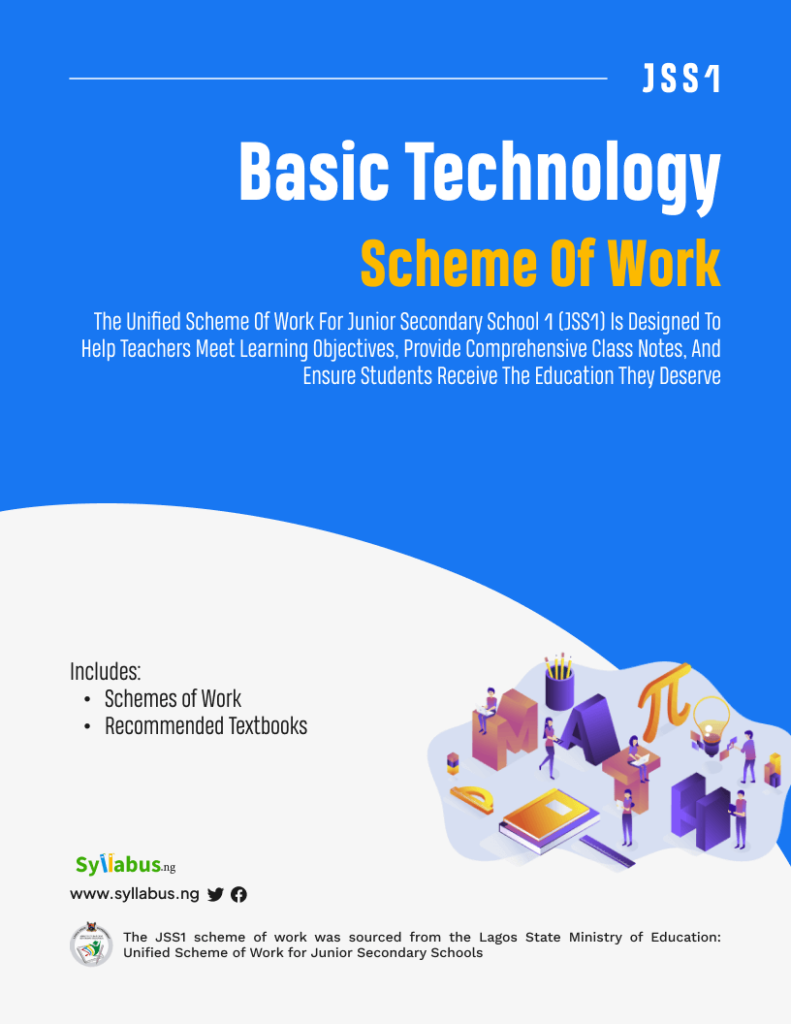Download the Junior Secondary School 1 (JSS1) Unified Scheme of Work for Basic Technology to serve as a guide for educators

Home » JSS1 Scheme of Work » JSS1 Basic Technology Scheme of WorkBasic Technology for Junior Secondary School 1 (JSS1) is a foundational subject that introduces students to essential technological concepts, skills, and knowledge. It helps students understand the definition, significance, and evolution of technology.
In Basic Technology for JSS1, students learn about the basic materials and processes that are required for technology to take place. It serves as a foundation for understanding the role of technology in everyday life and lays the groundwork for more advanced studies in subsequent years.
By studying Basic Technology in JSS1, students are exposed to theoretical and practical exercises that help them develop hands-on skills in handling tools safely and efficiently.
In junior secondary schools, assessment methods in Basic Technology may vary from one institution to another. However, the common approaches include regular tests or quizzes, known as Continuous Assessment Tests (CATs), and end-of-term exams.
Students’ performance is graded on a scale ranging from A to F. An A grade reflects outstanding achievement, corresponding to scores around 70% or 80%. An F grade indicates failure, typically associated with scores below 50% or 45%.

Know what’s expected of you as an educator
Download the Lagos State Unified Scheme of Work for JSS1 Basic Technology
| LAGOS STATE MINISTRY OF EDUCATION: UNIFIED SCHEMES OF WORK FOR JUNIOR SECONDARY SCHOOL | ||
| Basic Technology Scheme of Work for Junior Secondary School 1(JSS1) | ||
| Class | J.S.S.1 | |
| Subject | Basic Technology | |
| Term | First Term | |
| Week | Topic | Breakdown |
| 1 | UNDERSTANDING TECHNOLOGY | I. Technology related Professions II. Importance of Technology |
| 2 | SAFETY GUIDELINES | I. Safety Guidelines for Pedestrians II. Safety Guidelines for Cyclists/Motorcyclists III. Safety Guidelines for Motorists |
| 3 | WORKSHOP SAFETY I | I. Causes of Workshop Accidents II. Types of Workshop Accidents III. Prevention of Workshop Accidents |
| 4 | WORKSHOP SAFETY II | I. Safety Rules and Regulations in Workshop II. Safety Devices |
| 5 | PROPERTIES OF MATERIALS – WOOD I | I. Identification II. Classification |
| 6 | WOOD II | I. Properties II. Uses |
| 7 | PROPERTIES OF MATERIALS – METALS I | I. Identification by their Physical Properties II. Types III. Alloys |
| 8 | METALS II | I. Classification II. Forms of Metal III. Uses |
| 9 | PROPERTIES OF MATERIALS (CERAMICS AND GLASSES) | I. Identification II. Types III. Properties of Ceramics and Glasses IV. Uses |
| 10 | RUBBER AND PLASTICS | I. Types II. Identification III. Properties IV. Uses |
| 11 – 13 | REVISION AND EXAMINATION | |
| Term | Second Term | |
| Week | Topic | Breakdown |
| 1 | REVISION OF LAST TERM’S WORK | |
| 2 | TYPES OF BUILDING AND BUILDING MATERIALS I | I. Types of Building II. Types of Building Materials |
| 3 | BUILDING MATERIALS II | Uses |
| 4 | DRAWING INSTRUMENTS AND MATERIALS I | I. Types II. Uses |
| 5 | DRAWING INSTRUMENTS AND MATERIALS II | Care |
| 6 | BOARD PRACTICE I | I. Setting Drawing Paper on the Drawing Board II. Sharpening Pencil to Conical Point and Knife Edge III. Using Drawing Instruments to Draw Boarder Lines, Parallel Lines, Vertical Lines, Title Block, etc. |
| 7 | BOARD PRACTICE II | Lettering and Numerals |
| 8 | FREEHAND SKETCHING I | I. Definition II. Techniques of Drawing Lines, Curves, Circles and Irregular Shapes |
| 9 | FREEHAND SKETCHING I | Sketching of Simple Workshop Hand Tools – Building, Woodwork, Metalwork, Hand Tools |
| 10 | WORK BENCH FITTINGS AND APPLIANCES | I. List the Work Bench Fittings and Appliances II. Sketch the Work Bench Fittings and Appliances. III. Uses IV. Measuring Tools V. Marking out Tools |
| 11 -12 | REVISION AND EXAMINATION |
| Term | Third Term | |
| Week | Topic | Breakdown |
| 1 | REVISIONOF 2ND TERM’S WORK | |
| 2 | WOODWORK HAND TOOLS I | I. Boring Tools – Identify, List and State Uses II. Cutting Tools – Identify, List and State Uses |
| 3 | WOODWORK HANDTOOLS II | I. Driving and Impelling Tools – Identify, List and State Uses II. Holding Devices – Identify, List and State Uses III. Care and Maintenance |
| 4 | METALWORK HANDTOOLS I | I. Measuring Tools – Identify, List and State Uses II. Marking Out Tools – Identify, List and State Uses III. Holding Devices – Identify, List and State Uses |
| 5 | METALWORK HANDTOOLS II | I. Driving Tools – Identify, List and State Uses II. Cutting Tools/Boring Tools – Identify, List and State Uses III. Care and Maintenance |
| 6 | MAINTENANCE OF TOOLS AND MACHINES | I. Definition of Maintenance II. Types and Application III. Importance |
| 7 | BASIC ELECTRICITY I | I. Definition of Current II. Types of Current III. Definition of Electric Circuit and Its Components and Symbols |
| 8 | BASIC ELECTRICITY II | I. Measuring Instruments II. Definition of Transformer Stabilizer IIl. Appliances and Accessories |
| 9 | BASIC ELECTRICITY III | Simple Electrical Calculation |
| 10 | BASIC ELECTRICITY IV | I. Electrical Circuit Connections II. Simple Electrical Circuit Diagram |
| 11 -12 | REVISION AND EXAMINATION |
The following textbooks are recommended for Basic Technology in J.S.S.1.

Know what’s expected of you as an educator
Download the Lagos State Unified Scheme of Work for JSS1 Basic Technology